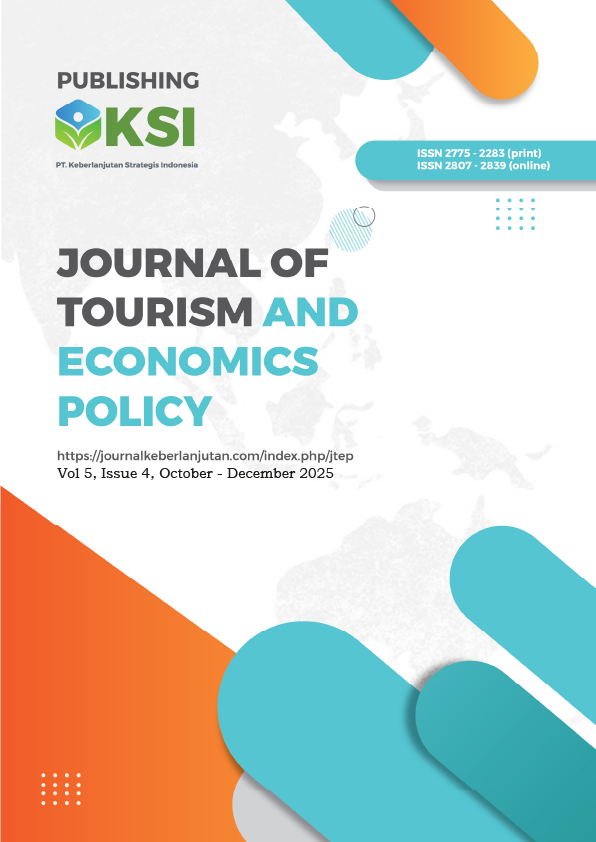Analysis of the Impact of Limited Infrastructure on Tourism Development in East Nusa Tenggara (NTT
DOI:
https://doi.org/10.38142/jtep.v5i4.1524Keywords:
Tourism Infrastructure, Tourism Development, East Nusa Tenggara, Regional Development, Tourism EconomyAbstract
East Nusa Tenggara (NTT) has tremendous tourism potential, ranging from stunning natural beauty to rich cultural diversity. However, this potential has not been optimally utilized, partly due to infrastructure limitations. This paper analyzes how infrastructure limitations, such as transportation accessibility, accommodation availability, and other supporting infrastructure, hinder tourism development in NTT. This study employs a qualitative approach using literature review and secondary data analysis to identify the significant impacts of infrastructure limitations on tourism sector growth, local community income, and environmental conservation. The findings reveal that infrastructure limitations significantly hinder NTT's competitiveness as a tourist destination, limit economic opportunities for local communities, and pose a risk of environmental damage if not managed properly. This paper also offers policy recommendations to address these issues, including strategic infrastructure investment, public- private partnerships, and sustainable tourism development.
References
Badan Pusat Statistik Provinsi Nusa Tenggara Timur. (2023). Provinsi Nusa Tenggara Timur Dalam Angka 2023. BPS NTT.
Badan Pusat Statistik Nusa Tenggara Timur. (2024). Provinsi Nusa Tenggara Timur Dalam Angka 2024. BPS NTT.
Brida, J. G., & Risso, W. A. (2009). The impact of tourism on economic growth: The case of Mexico.
Tourism Economics, 15(4), 743-752.
Dwyer, L. & Kim, C. (2003). Destination Competitiveness: Determinants and Indicators.
Current Issues in Tourism, 6(5), 369-402.
Dwyer, L., & Forsyth, P. (2006). Tourism economics and policy. Channel View Publications.
Goeldner, C.R. & Ritchie, J.R.B. (2009). Tourism: Principles, Practices, Philosophies (11th ed.). John Wiley & Sons.
Gössling, S., & Hall, C. M. (2006). Tourism and global environmental change: Ecological, social, economic and political perspectives. Routledge.
Hall, C. M., & Page, S. J. (2009). The Geography of Tourism and Recreation: Environment, Place and Space (3rd ed.). Routledge.
Henderson, J. C. (2003). Responding to the unexpected: Infrastructure and tourism in Singapore.
Tourism Management, 24(6), 717-723.
Inskeep, E. (1991). Tourism Planning: An Integrated and Sustainable Development Approach. Van Nostrand Reinhold.
Kementerian Pekerjaan Umum dan Perumahan Rakyat. (2023). Laporan Tahunan Direktorat Jenderal Bina Marga [atau sesuai data yang relevan]. Kementerian PUPR.
Khan, M. H. (2013). Infrastructure development and tourism growth in Pakistan. European Journal of Business and Social Sciences, 2(6), 140-150.
Laporan Bank Indonesia Perwakilan Nusa Tenggara Timur. (2023). Kajian Ekonomi dan Keuangan Regional Provinsi Nusa Tenggara Timur. Bank Indonesia.
Lumsdon, L. (2004). Tourism marketing. Thomson Learning.
Prideaux, B. (2000). The role of the transport system in destination development. Tourism Management, 21(1), 53-63.
UNWTO. (2004). Tourism and Poverty Alleviation. UNWTO.
UNWTO. (2010). Understanding Tourism: Basic Glossary. UNWTO.
United Nations World Tourism Organization (UNWTO). (2018). Tourism and the Sustainable Development Goals: Journey to 2030. UNWTO.
World Tourism Organization (WTO). (1999). Guide for Local Authorities on Developing Sustainable Tourism. WTO.
Downloads
Published
Issue
Section
License
Copyright (c) 2025 Afli sangsun JEHAMUR, Melkisedek N.B.C. NEOLAKA, Maria Magdalena. LINO, Syukur M. Adang DJAHA

This work is licensed under a Creative Commons Attribution-NonCommercial 4.0 International License.
Creative Commons Attribution-NonCommercial 4.0 International License.





















